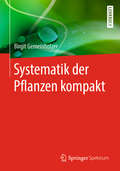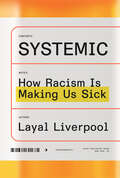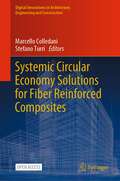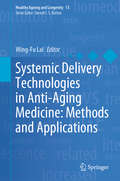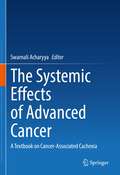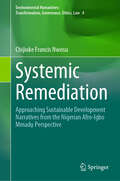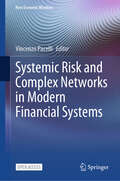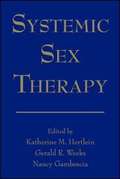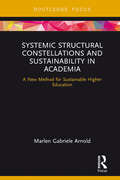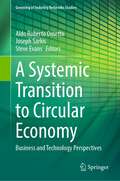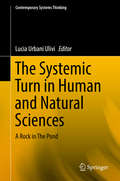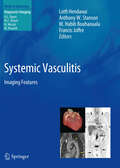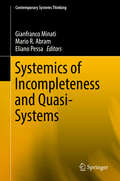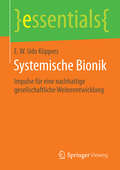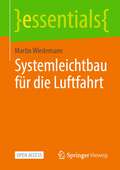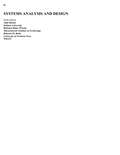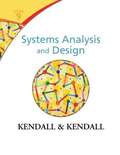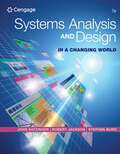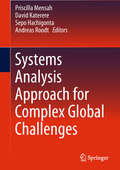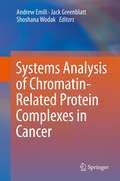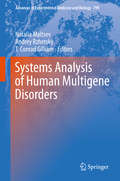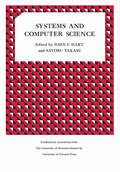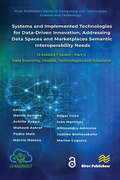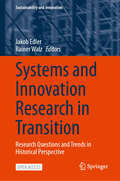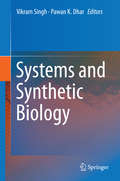- Table View
- List View
Systematik der Pflanzen kompakt
by Birgit GemeinholzerDieses Kompakt-Lehrbuch vermittelt ein grundlegendes Verständnis für die Klassifizierung von Pflanzen und gibt Einblicke in den Artenreichtum der Pflanzenwelt. Es richtet sich an Bachelor- und Masterstudierende der verschiedensten Fachrichtungen. Die Autorin beschreibt hierzu die Pflanzensystematik auf dem aktuellsten Stand der Wissenschaft. Nach einer fundierten Einleitung zu den Grundlagen der Systematik, Taxonomie, Nomenklatur und Evolutionsforschung, lernt der Leser die einzelnen Pflanzengruppen und ihre Merkmale kennen. Das im Text vermittelte Fachwissen wird mithilfe von zahlreichen detaillierten Abbildungen veranschaulicht, was zu einem guten Verständnis des Buches und schnellem Lernerfolg beiträgt.
Systemic: How Racism Is Making Us Sick
by Layal LiverpoolIn the spirit of Medical Apartheid and Killing the Black Body; A science-based, data-driven, and global exploration of racial disparities in health care access by virologist, immunologist, and science journalist Layal Liverpool.Layal Liverpool spent years as a teen bouncing from doctor to doctor, each one failing to diagnose her dermatological complaint. Just when she&’d grown used to the idea that she had an extremely rare and untreatable skin condition, one dermatologist, after a quick exam, told her that she had a classic (and common) case of eczema and explained that it often appears differently on darker skin. Her experience stuck with her, making her wonder whether other medical conditions might be going undiagnosed in darker-skinned people and whether racism could, in fact, make people sick.The pandemic taught us that diseases like Covid disproportionately affect people of color. Here, Liverpool goes a step further to show that this disparity exists for all types of illness and that it is caused by racism. In Systemic, Liverpool shares her journey to show how racism, woven into our societies, as well as into the structures of medicine and science, is harmful to our health. Refuting the false belief that there are biological differences between races, Liverpool goes on to show that racism-related stress and trauma can however, lead to biological changes that make people of color more vulnerable to illness, debunking the myth of illness as the great equalizer.From the problem of racial bias in medicine where the default human subject is white, to the dangerous health consequences of systemic racism, from the physical and psychological effects of daily microaggressions to intergenerational trauma and data gaps, Liverpool reveals the fatal stereotypes that keep people of color undiagnosed, untreated, and unsafe, and tells us what we can do about it.
Systemic Circular Economy Solutions for Fiber Reinforced Composites (Digital Innovations in Architecture, Engineering and Construction)
by Marcello Colledani Stefano TurriThis open access book provides an overview of the work undertaken within the FiberEUse project, which developed solutions enhancing the profitability of composite recycling and reuse in value-added products, with a cross-sectorial approach. Glass and carbon fiber reinforced polymers, or composites, are increasingly used as structural materials in many manufacturing sectors like transport, constructions and energy due to their better lightweight and corrosion resistance compared to metals. However, composite recycling is still a challenge since no significant added value in the recycling and reprocessing of composites is demonstrated. FiberEUse developed innovative solutions and business models towards sustainable Circular Economy solutions for post-use composite-made products. Three strategies are presented, namely mechanical recycling of short fibers, thermal recycling of long fibers and modular car parts design for sustainable disassembly and remanufacturing. The validation of the FiberEUse approach within eight industrial demonstrators shows the potentials towards new Circular Economy value-chains for composite materials.
Systemic Delivery Technologies in Anti-Aging Medicine: Methods and Applications (Healthy Ageing and Longevity #13)
by Wing-Fu LaiThis book presents a multidisciplinary assessment of the state of science in the use of systemic delivery technologies to deliver anti-aging therapeutics now under development. There is a gap between basic aging research and the development of intervention technologies. This major obstacle must be overcome before biogerontological interventions can be put into clinical practice. As biogerontology comes to understand aging as a systemic degenerative process, it is clear that there is a pressing need for technologies that enable cells and tissues in a fully developed adult body to be manipulated systemically to combat aging. The authors review advances in the chemistry and engineering of systemic delivery methods and analyze the strengths and limitations of each.The book is organized into six sections. The first offers an overview of the need for systemic delivery technologies alongside the development of anti-aging therapies and describes approaches that will be required for studying the properties and efficiency of carriers for systemic delivery. Sections II, III and IV describe recent advances in a range of strategies that may enable systemic delivery to help combat aging conditions ranging from cell senescence to decline in immune function and hormonal secretion. Section V discusses practical strategies to engineer and optimize the performance of delivery technologies for applications in systemic delivery, along with their working principles. The final section discusses technical and biological barriers that must be overcome as systemic delivery technologies move from research laboratory to clinical applications aimed at tackling aging and age-associated diseases.Benefiting scholars, students and a broader audience of interested readers, the book includes helpful glossary sections in each chapter, as well as sidebars that highlight important notes, and questions for future research.
The Systemic Effects of Advanced Cancer: A Textbook on Cancer-Associated Cachexia
by Swarnali AcharyyaThis textbook discusses the systemic consequences of cancer, covering a range of topics from tumor-promoting systemic effects to the development of cachexia, as summarized in the introductory chapter 1. Part I of this textbook focuses on tumor-promoting systemic effects and begins with a chapter on how tumor-derived extracellular vesicles and particles lay the foundation for future metastases (Chapter 2). Chapter 3 discusses how metastatic cells that have colonized the bone impact the local bone microenvironment, neighboring muscles, and host physiology. Chapter 4 summarizes the available strategies for targeting metastatic cancer and emphasizes the need to incorporate a systemic view of the disease. Following this overview of the systemic effects of cancer progression, Part II of the textbook discusses cancer-induced cachexia, a debilitating systemic effect of advanced cancer. Chapters 5-7 examine the key signaling pathways (interleukin-6/GP130, NF-kB, and muscle proteolysis) that drive the development of cancer cachexia. Chapters 8 and 9 in Part III of this textbook explore how toxicities from anti-cancer therapy are associated with the onset of cachexia in cancer patients, and provide insight into potential approaches to simultaneously target both cancer and cachexia. Chapters 10 and 11 (Part IV) conclude this textbook by outlining promising approaches for the diagnosis and treatment of cachexia as well as strategies to prevent the development of cachexia through exercise. An understanding of the systemic effects of cancer is essential for the design of effective anti-cancer and anti-cachexia treatment strategies. As such, this textbook provides key information for both students and scientists engaged in cancer research and oncology.
Systemic Remediation: Approaching Sustainable Development Narratives from the Nigerian Afro-Igbo Mmadụ Perspective (Environmental Humanities: Transformation, Governance, Ethics, Law #4)
by Chijioke Francis NwosuSince the issues and discourses surrounding sustainable development entered its phase in our contemporary world, the political, social, economic, ecological, and cultural existence of our modern world has inevitably adopted varied measures to respond better to the demands of our time. This book contributes to the global call for transitions and transformations towards a more sustainable human society. This contribution is specific, dialogic and comparative and also has deep cultural and ethnological consciousness based on the Nigerian experiences and, by extension, the African experience. The research work presents as its background the hypothesis that varied forms of structures—socio-political, socio-economic, socio-ecological and socio-cultural—unite to constitute ‘structural sins’ (John Paul II) and, consequently, the banes to authentic and sustainable development. These dysfunctional structures were critically analysed and evaluated. Furthermore, the research work takes up the contemporary discourse on sustainable development, beginning with earlier development concepts, the impactful contribution of social documents of the church to development discourse, the timeline of the general global and sustainable development approach and governance, as well as the specifics of the twin documents of the year 2015, namely Agenda 2030 and Laudato Si. Again, an indigenised manuscript for development discourse known as Nigeria Vision 20:2020 was examined to delineate the fact that forms of indigenous efforts to discuss and administrate the development process are noticeable. However, such efforts have remained negatively exploited by both internal and external man-made corrupt factors. One such factors discussed in this book, among others, is the failure of Nigeria since independence to stabilise its power and energy sector.
Systemic Risk and Complex Networks in Modern Financial Systems (New Economic Windows)
by Vincenzo PacelliThis open access book is a groundbreaking exploration of systemic risk in modern financial systems. Through its theoretical and empirical investigations, it reveals the multidimensionality of systemic risk, the transmission channels of crises, and the interlinkages between physical, transition, and financial risks. It introduces cutting-edge methodologies, including prediction and optimization models based on complex networks, multilayer networks and eXplainable Artificial Intelligence (XAI) approaches, to forecast and measure systemic risk and financial crisis. It provides insight for academics, practitioners, policy and supervisory authorities, and bankers and financial market operators on understanding the links that determine the propagation of financial crises and the emergence of systemic risks. This book is essential for those wishing to better understand systemic risk and its implications.
Systemic Sex Therapy
by Katherine Milew Hertlein Gerald Weeks Nancy Gambescia Katherine M. Hertlein Gerald R. WeeksSystemic Sex Therapyserves as an introduction to the field of sex therapy from a systems perspective. It is an excellent resource for graduate students in marriage and family therapy programs or students and professionals who want a truly fresh perspective on sex therapy. This approach moves beyond traditional behavioral approaches to incorporate individual, couple, and intergenerational factors in etiology and treatment. Unlike current books on the market that are outdated, too advanced, simplistic, unfocused, or too diffuse in content, Systemic Sex Therapyis comprehensive, concise, highly focused on treatment, user-friendly, and contains features not found in other sex therapy texts, such as a systemic/behavioral focus, clinical innovation, and a greater focus on implementation rather than competing works.
Systemic Structural Constellations and Sustainability in Academia: A New Method for Sustainable Higher Education
by Marlen ArnoldIn order to create truly sustainable universities, we require new methods of visualising and interpreting them holistically as institutions built on complex relationships and systems, rather than as individual departments and people operating independently. This book uses a systemic structural constellations approach to demonstrate how we can build more sustainable higher education institutions, both in terms of teaching and research and at an operational level. Drawing examples from current research and teaching, Systemic Structural Constellations and Sustainability in Academia explores how universities are not only centres of teaching and learning but can also play a crucial role in enabling future decision-makers to appreciate and contribute to a more sustainable future. Providing a clear introduction to systemic structural constellations and guidance on how to practically apply the theory to numerous aspects of the higher education system, this book will be of great interest to students and researchers of education for sustainable development, organisational learning and sustainable management, as well as those tasked with transforming the higher education system for the future.
A Systemic Transition to Circular Economy: Business and Technology Perspectives (Greening of Industry Networks Studies #12)
by Aldo Roberto Ometto Joseph Sarkis Steve EvansThe book will explore, using multiple perspectives from multiple contributors, two main aspects for circular economy (CE) business and technology (B&T): systems and value perspectives. Going beyond a linear-economic perspective--the traditional perspective--CE needs to develop intentional and integrated paths to help restore physical resources and regenerate the functions of natural and anthropic systems, creating greater economic and social opportunities, with environmentally positive outcomes. Whether this is feasible and possible within the context of CE and B&T is something that will be central to the contributions made in this book. A major objective of the book is to deliver practical and fundamental knowledge of B&T CE insights combining a systems perspective and value creation for socio-technical innovation leading to sustainable transitions and effective transformations. Based on those key aspects, the book is structured in two parts, one from a more theoretical and conceptual basis in Part 1, and a more applied perspective in Part 2. The chapters in Part 1 are presented through the lens of business and systems transitions. In Part 2, the chapters present the opportunities and the journeys from real case studies of companies engaged in circular business strategies, processes, practices, and technologies.
The Systemic Turn in Human and Natural Sciences: A Rock In The Pond (Contemporary Systems Thinking)
by Lucia Urbani UliviThis book is dedicated to the consolidation and to the expansion of theoretic systems thinking as a necessary integration of the general reductionist and analytical attitude dominant in our culture. Reductionism and analytical approaches have produced significant results in many fields of contemporary knowledge giving a great contribution to relevant scientific discoveries and to their technological application, but their validity has been improperly universalized as the only and best methods of knowledge in every domain. It is nowadays clear that analytical or mereological approaches are inadequate to solve many problems and that we should introduce – or support the diffusion of - new concepts and different research attitudes.A good candidate to support such a shift is the well known theoretical approach based on the concept of “system” that no more considers the elementary constituents of an object, but the entity emerging from the relations and interactions among its elementary parts. It becomes possible to reconstruct several domains, both philosophical and scientific, from the systemic point of view, introducing fresh ideas in the research in view of a general rational vision of the world on more comprehensive basis.This book contributes to the diffusion and evolution of systemic thinking by focusing on two main objectives: developing and updating the systemic approach in disciplines currently using it and introducing the systemic perspective in humanistic disciplines, where the approach is not widely used. The Systemic Turn in Human and Natural Sciences: A Rock in the Pond is comprised of ten chapters. The chapter authors adopt a trans-disciplinary perspective, consisting in the recognition and harmonization of the special outlooks that together, within the general systemic paradigm, gives an ideal unity to the book.
Systemic Vasculitis
by M. Habib Bouhaouala Anthony W. Stanson Lotfi Hendaoui Francis JoffreThe prompt diagnosis of systemic vasculitis is essential as a missed diagnosis can be disastrous. Imaging is of vital importance in achieving a correct diagnosis and in some cases also plays a role in endovascular treatment. In this book, the imaging features of the many different types of vasculitis are clearly demonstrated by means of numerous high-quality illustrations. All relevant imaging modalities are considered, and key distinctive characteristics are highlighted. In addition, each chapter discusses the etiology, epidemiology, pathogenesis, clinical presentation, biology, and treatment of the vasculitis in question. This book is the result of cooperation between expert teams from a range of countries. The wealth of illustrations and informative clinical case studies will prove invaluable for all who may be confronted with these problematic disorders.
Systemics of Incompleteness and Quasi-Systems (Contemporary Systems Thinking)
by Gianfranco Minati Mario R. Abram Eliano PessaThis book contains the proceedings of the Seventh National Conference of the Italian Systems Society. The title, Systemics of Incompleteness and Quasi-Systems, aims to underline the need for Systemics and Systems Science to deal with the concepts of incompleteness and quasiness. Classical models of Systemics are intended to represent comprehensive aspects of phenomena and processes. They consider the phenomena in their temporal and spatial completeness. In these cases, possible incompleteness in the modelling is assumed to have a provisional or practical nature, which is still under study, and because there is no theoretical reason why the modelling cannot be complete. In principle, this is a matter of non-complex phenomena, to be considered using the concepts of the First Systemics. When dealing with emergence, there are phenomena which must be modelled by systems having multiple models, depending on the aspects being taken into consideration. Here, incompleteness in the modelling is intrinsic, theoretically relating changes in properties, structures, and status of system. Rather than consider the same system parametrically changing over time, we consider sequences of systems coherently. We consider contexts and processes for which modelling is incomplete, being related to only some properties, as well as those for which such modelling is theoretically incomplete—as in the case of processes of emergence and for approaches considered by the Second Systemics. In this regard, we consider here the generic concept of quasi explicating such incompleteness. The concept of quasi is used in various disciplines including quasi-crystals, quasi-particles, quasi-electric fields, and quasi-periodicity. In general, the concept of quasiness for systems concerns their continuous structural changes which are always meta-stable, waiting for events to collapse over other configurations and possible forms of stability; whose equivalence depends on the type of phenomenon under study. Interest in the concept of quasiness is not related to its meaning of rough approximation, but because it indicates an incompleteness which is structurally sufficient to accommodate processes of emergence and sustain coherence or generate new, equivalent or non-equivalent, levels. The conference was devoted to identifying, discussing and understanding possible interrelationships of theoretical disciplinary improvements, recognised as having prospective fundamental roles for a new Quasi-Systemics. The latter should be able to deal with problems related to complexity in more general and realistic ways, when a system is not always a system and not always the same system. In this context, the inter-disciplinarity should consist, for instance, of a constructionist, incomplete, non-ideological, multiple, contradiction-tolerant, Systemics, always in progress, and in its turn, emergent.
Systemische Bionik: Impulse für eine nachhaltige gesellschaftliche Weiterentwicklung (essentials)
by E. W. Udo KüppersDieses Essential vermittelt einen grundlegenden Einblick in die Systemische Bionik als Grenzen überwindende Disziplin. Der Autor erläutert auf leicht verständliche Weise, welchen Wert die Bionik für ganzheitliche Problemlösungen bietet und welche Rolle eine intakte Natur dabei spielt. Wegweisend und zielführend bei diesem systembionischen Vorgehensmodell ist das Erkennen von Zusammenhängen in Natur und Technik.
Systemleichtbau für die Luftfahrt (essentials)
by Martin Wiedemannessentials liefern aktuelles Wissen in konzentrierter Form. Die Essenz dessen, worauf es als „State-of-the-Art“ in der gegenwärtigen Fachdiskussion oder in der Praxis ankommt. essentials informieren schnell, unkompliziert und verständlichals Einführung in ein aktuelles Thema aus Ihrem Fachgebietals Einstieg in ein für Sie noch unbekanntes Themenfeldals Einblick, um zum Thema mitreden zu könnenDie Bücher in elektronischer und gedruckter Form bringen das Fachwissen von Springerautor*innen kompakt zur Darstellung. Sie sind besonders für die Nutzung als eBook auf Tablet-PCs, eBook-Readern und Smartphones geeignet. essentials sind Wissensbausteine aus den Wirtschafts-, Sozial- und Geisteswissenschaften, aus Technik und Naturwissenschaften sowie aus Medizin, Psychologie und Gesundheitsberufen. Von renommierten Autor*innen aller Springer-Verlagsmarken.Dies ist ein Open-Access-Buch.
Systems Analysis And Design
by Alan Dennis Barbara Haley Wixom Roberta M. RothThe 6th Edition of Systems Analysis and Design continues to offer a hands-on approach to SAD while focusing on the core set of skills that all analysts must possess. Building on their experience as professional systems analysts and award-winning teachers, authors Dennis, Wixom, and Roth capture the experience of developing and analyzing systems in a way that students can understand and apply. With Systems Analysis and Design, 6th Edition, students will leave the course with experience that is a rich foundation for further work as a systems analyst.
Systems Analysis and Design
by Kenneth E. Kendall Julie E. KendallExpanded coverage of emerging technologies, such as agile methods, cloud computing, and mobile applications, complements this book’s traditional approaches to systems analysis and design. A wealth of real-world examples emphasizes critical thinking and IT skills in a dynamic, business-related environment. You will find numerous projects, insightful assignments, and helpful end-of-chapter exercises to help you refine the IT skills you need for success in today's intensely competitive business world.
Systems Analysis and Design in a Changing World
by John W. Satzinger Robert B. Jackson Stephen D. BurdReflecting the latest practices, trends, and developments from the field, SYSTEMS ANALYSIS AND DESIGN IN A CHANGING WORLD, 7E equips you with a solid foundation of the most important principles of systems analysis, systems design, project management, and new software development approaches. Using case driven techniques, the succinct 14-chapter book focuses on content that is key to your success in today's market. The book teaches both traditional (structured) and object-oriented (OO) approaches to systems analysis and design. It highlights use cases, use diagrams, and use case descriptions required for a modeling approach, while demonstrating their application to traditional, web development, object-oriented, and service-oriented architecture approaches. Content reflects Microsoft Project 2013 Professional and Microsoft Visio 2013.
Systems Analysis Approach for Complex Global Challenges
by Priscilla Mensah David Katerere Sepo Hachigonta Andreas RoodtThis book, which contains a collection of review articles as well as focus on evidence-based policy making, will serve as a valuable resource not just for all postgraduate students conducting research using systems analysis thinking but also for policy makers. To our knowledge, a book of this nature which also has a strong African focus is currently not available. The book examines environmental and socio-economic risks with the aim of providing an analytical foundation for the management and governance of natural resources, disasters, addressing climate change, and easing the technological and ecological transitions to sustainability. It provides scientific and strategic analysis to better understand the dynamics of future energy transitions, their main driving forces, enabling factors, barriers, as well as their consequences for the social, economic and environmental dimensions of human wellbeing. Science-based policy advice is achieved through an integrated assessment and modeling of how to simultaneously address the major energy policy challenges in the areas of environment (climate change and air pollution), energy poverty (or access to affordable and clean energy for the poor), energy security and reliability. It also aims to improve our understanding of ecosystems and their management in today’s changing world—in particular, the current state of ecosystems, and their ecological thresholds and buffering capacities. It provides support for policy makers in developing rational, realistic and science-based regional, national and global strategies for the production of fuel, food and fibre that sustain ecosystem services and safeguard food security. Finally, it addresses the human development dimension of global change based on comprehensive studies on the changing size and composition of human populations around the world by analyzing both their impacts and the differential vulnerabilities by age, gender and level of education.
Systems Analysis of Chromatin-Related Protein Complexes in Cancer
by Andrew Emili Shoshana Wodak Jack GreenblattEpigenetic modifications underlie all aspects of human physiology, including stem cell renewal, formation of cell types and tissues. They also underlie environmental impacts on human health, including aging and diseases like cancer. Consequently, cracking the epigenetic "code" is considered a key challenge in biomedical research. Chromatin structure and function are modified by protein complexes, causing genes to be turned "on" or "off" and controlling other aspects of DNA function. Yet while there has been explosive growth in the epigenetics field, human chromatin-modifying machines have only recently started to be characterized. To meet this challenge, our book explores complementary experimental tracks, pursued by expert international research groups, aimed at the physical and functional characterization of the diverse repertoire of chromatin protein machines - namely, the "readers, writers and erasers" of epigenomic marks. These studies include the identification of RNA molecules and drugs that interact selectively with components of the chromatin machinery. What makes this book distinctive is its emphasis on the systematic exploration of chromatin protein complexes in the context of human development and disease networks.
Systems Analysis of Human Multigene Disorders
by Natalia Maltsev Andrey Rzhetsky T. Conrad GilliamUnderstanding the genetic architecture underlying complex multigene disorders is one of the major goals of human genetics in the upcoming decades. Advances in whole genome sequencing and the success of high throughput functional genomics allow supplementing conventional reductionist biology with systems-level approaches to human heredity and health as systems of interacting genetic, epigenetic, and environmental factors. This integrative approach holds the promise of unveiling yet unexplored levels of molecular organization and biological complexity. It may also hold the key to deciphering the multigene patterns of disease inheritance.
Systems and Computer Science: Proceedings of a Conference held at the University of Western Ontario September 10-11, 1965
by John Hart Satoru TakasuThis book presents the papers delivered at the Conference on Systems and Computer Science held at the University of Western Ontario in September 1965. The primary purposes of the Conference were the promotion of research and the development of the teaching of computer science in Canadian universities. The papers focus attention on some of the concepts of Computer Science as a new field of study and at the same time provide a background for scientists looking at the subject for the first time. The chief developments in computer science have been concerned with the "applied" rather than the "pure" areas of the field: numerical analysis, applied statistics and operations research, and data processing. But there is something more to computers than the physical components and this book represents an attempt to correct the imbalance between "applied" and "pure" by drawing attention to certain theoretical aspects of computer and information science. Among the topics discussed are the theory of finite and infinite automata, aspects of formal language theory, heuristic and non-heuristic approaches to theorem proving and the mathematical formulation of the theory of general systems. There are also references to the problems of machine design, to software systems including higher-level languages, to multiple control computer models and to applied systems. This collection of papers will appeal first to graduate students and professors in Computer Science. It will also be of interest to computer scientists in industry and in government and university research groups and to the scientific public interested in discovering some of the principal ingredients and directions of the computer and information sciences.
Systems and Implemented Technologies for Data-Driven Innovation, addressing Data Spaces and Marketplaces Semantic Interoperability Needs: i3-MARKET Series - Part II: Data Economy, Models, Technologies and Solutions (River Publishers Series in Computing and Information Science and Technology)
by Martín Serrano Achille Zappa Waheed Ashraf Pedro Maló Márcio Mateus Edgar Fries Iván Martínez Alessandro Amicone Justina Bieliauskaite Marina CugurraIn the second i3-MARKET series book we review the basic technological principles, software best practices, and standards for implementing and deploying data spaces and data marketplaces. The book provides a definition for data-driven society as: The process to transform data production into data economy for the people using the emerging technologies and scientific advances in data science to underpin the delivery of data economic models and services. This book further discusses why data spaces and data marketplaces are the focus in today’s data-driven society as the trend to rapidly transform the data perception in every aspect of our activities. In this book, technology assets that are designed and implemented following the i3-MARKET backplane reference implementation (WebRI) that uses open data, big data, IoT and AI design principles is introduced. Moreover, the series of software assets grouped as sub-systems and composed by software artefacts are included and explained in full. Further, we describe i3-MARKET backplane tools and how these can be used for supporting marketplaces and its components including details of available data assets. Next, we provide descriptions of solutions developed in i3-MARKET as an overview of the potential for being the reference open-source solution to improve data economy across different data marketplaces.
Systems and Innovation Research in Transition: Research Questions and Trends in Historical Perspective (Sustainability and Innovation)
by Jakob Edler Rainer WalzIn the last decades it has become more and more imperative for our societies, and for decision makers in all areas of society, to understand the dynamics through which innovation systems develop and through which socio-technical systems transform themselves. As both innovation and transformation are strongly intertwined, it has equally become imperative to analyse their dynamics as well as their interplay. This open access volume reflects on the research fields that have developed in the last five decades to do exactly that. It defines and delineates research on systems and innovation as encompassing the scientific study of, first, the conditions, dynamics and impacts associated with the generation and uptake of innovations and, second, the development and transformation of functional systems satisfying essential needs such as the provision of energy or water. Further, the area of Systems and Innovation Research (SIR) is characterised by problem and stakeholder oriented research. We chose five decades as time frame because we noted that roughly 50 years ago a number of research institutes dedicated to SIR were founded and the SIR area started to grow significantly. We present a systematic history of nine selected fields within the area of SIR (Innovation policy, Innovation indicators, Foresight, Policy Evaluation, Technology Assessment, Production Paradigms, Renewable Energies, Energy Efficiency, Water Use). We also present a conceptual framework to understand the processes by which the research fields have developed. This allows to draw general lessons as to what drives fields throughout their development and how their role vis-à-vis policy, businesses and societies changes over time. It also allows to speculate about future challenges and trends in the SIR area. This is important because, if anything, the need to govern transformation through innovation will further grow in the future, and with it the need to understand the underlying dynamics.
Systems and Synthetic Biology
by Vikram Singh Pawan K. DharThis textbook has been conceptualized to provide a detailed description of the various aspects of Systems and Synthetic Biology, keeping the requirements of M. Sc. and Ph. D. students in mind. Also, it is hoped that this book will mentor young scientists who are willing to contribute to this area but do not know from where to begin. The book has been divided into two sections. The first section will deal with systems biology - in terms of the foundational understanding, highlighting issues in biological complexity, methods of analysis and various aspects of modelling. The second section deals with the engineering concepts, design strategies of the biological systems ranging from simple DNA/RNA fragments, switches and oscillators, molecular pathways to a complete synthetic cell will be described. Finally, the book will offer expert opinions in legal, safety, security and social issues to present a well-balanced information both for students and scientists.
